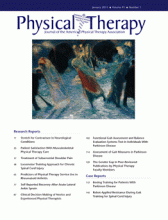Abstract
Background Gait impairments, balance impairments, and falls are prevalent in individuals with Parkinson disease (PD). Although the Berg Balance Scale (BBS) can be considered the reference standard for the determination of fall risk, it has a noted ceiling effect. Development of ceiling-free measures that can assess balance and are good at discriminating “fallers” from “nonfallers” is needed.
Objective The purpose of this study was to compare the Functional Gait Assessment (FGA) and the Balance Evaluation Systems Test (BESTest) with the BBS among individuals with PD and evaluate the tests' reliability, validity, and discriminatory sensitivity and specificity for fallers versus nonfallers.
Design This was an observational study of community-dwelling individuals with idiopathic PD.
Methods The BBS, FGA, and BESTest were administered to 80 individuals with PD. Interrater reliability (n=15) was assessed by 3 raters. Test-retest reliability was based on 2 tests of participants (n=24), 2 weeks apart. Intraclass correlation coefficients (2,1) were used to calculate reliability, and Spearman correlation coefficients were used to assess validity. Cutoff points, sensitivity, and specificity were based on receiver operating characteristic plots.
Results Test-retest reliability was .80 for the BBS, .91 for the FGA, and .88 for the BESTest. Interrater reliability was greater than .93 for all 3 tests. The FGA and BESTest were correlated with the BBS (r=.78 and r=.87, respectively). Cutoff scores to identify fallers were 47/56 for the BBS, 15/30 for the FGA, and 69% for the BESTest. The overall accuracy (area under the curve) for the BBS, FGA, and BESTest was .79, .80, and .85, respectively.
Limitations Fall reports were retrospective.
Conclusion Both the FGA and the BESTest have reliability and validity for assessing balance in individuals with PD. The BESTest is most sensitive for identifying fallers.
Footnotes
All authors provided concept/idea/research design and data collection. Ms Leddy provided writing, data analysis, and clerical support. Ms Leddy and Dr Earhart provided project management and fund procurement. Dr Crowner and Dr Earhart provided participants and consultation (including review of manuscript before submission). Dr Earhart provided facilities/equipment. Special thanks go to all of the research participants for their time, as well as to Ryan Duncan, John Michael Rotello, and Vanessa Heil-Chapdelaine for their help with data collection.
The study was approved by the Human Research Protection Office of Washington University School of Medicine.
This research was presented in abstract/poster format at the Missouri Physical Therapy Association Spring Conference; April 16–18, 2010; St Louis, Missouri; at the National Predoctoral Clinical Research Training Program Meeting; May 3–4, 2010; St Louis, Missouri; and at the World Parkinson Congress; September 28–October 1, 2010; Glasgow, Scotland.
This publication was directly funded by the Davis Phinney Foundation and grant UL1 RR024992 and sub-award TL1 RR024995 from the National Center for Research Resources (NCRR), a component of the National Institutes of Health (NIH), and NIH Roadmap for Medical Research. Additional support was provided by the Greater St Louis Chapter of the American Parkinson Disease Association (APDA) and the APDA Center for Advanced PD Research at Washington University. Its contents are solely the responsibility of the authors and do not necessarily represent the official view of the Davis Phinney Foundation, NCRR, NIH, or the APDA.
- Received March 31, 2010.
- Accepted August 15, 2010.












